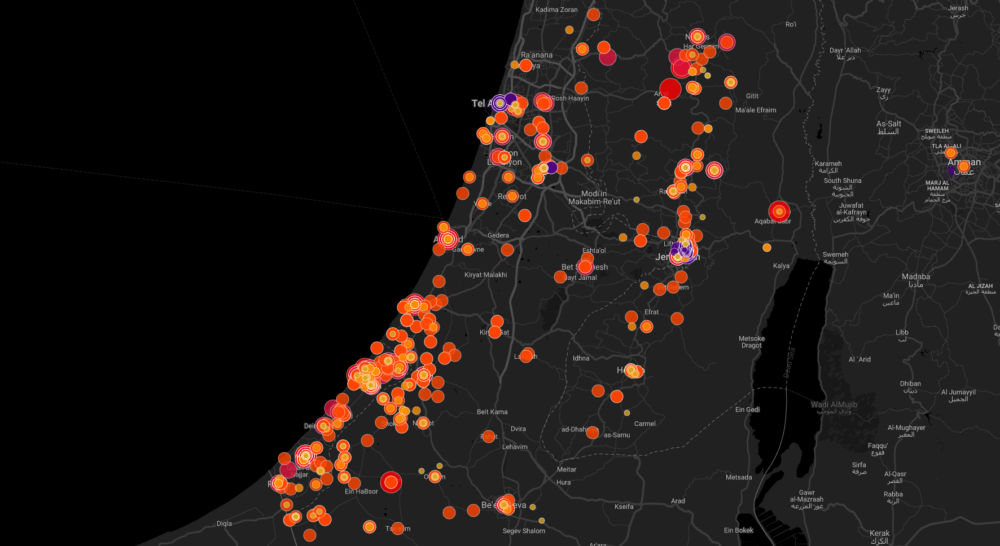By Cory Bergman and Ahmed Namatalla
Misinformation and disinformation have been cornerstones in the long, complicated conflict in Israel and the Palestinian territories, but the latest confrontations set a new benchmark for the speed, scope and sophistication of information warfare.
More than a week into the latest unrest, Israeli forces destroyed several buildings that housed local and international media outlets, including a tower that was home to the Associated Press and Al Jazeera. Israel claims the buildings housed Hamas operations, but at least 18 media outlets were impacted, according to the Committee to Protect Journalists. At the same time, international media was banned from entering the Gaza Strip from Israeli territory.
Further complicating relations with the media, the IDF spread a false story about a non-existent ground invasion that was allegedly designed to dupe Palestinian militants into exposing their positions — IDF, for it’s part, said the report was an “honest mistake.” The information war is just part of the war.
This brings new challenges to understanding one of the most important news events in the Middle East in recent memory. The diminished coverage from inside the Gaza Strip creates an information vacuum of on-the-ground reporting, and false statements from official military sources only fuel more skepticism. Both news organizations and the public are left to parse through less familiar and less credible sources amid the cacophony of noise.
“A lot of it is rumor and broken telephone, but it is being shared right now because people are desperate to share information about the unfolding situation,” said Arieh Kovler, a political analyst and misinformation researcher in Jerusalem who spoke with the New York Times. “What makes it more confusing is that it is a mix of false claims and genuine stuff, which is being attributed to the wrong place or the wrong time.”
Over this latest period of Israeli-Palestinian conflict, Factal verified more than 1,900 updates for global companies and NGOs that need the facts to keep people safe. Verification begins with sourcing, and we’ve vetted thousands of news sources from every region in the world. We favor local sources with consistent track records, and we compare their reports to corroborate the facts. The fewer the trusted sources – as we’ve experienced in Myanmar through the military’s crackdown on journalism and the internet – the harder it is to understand what’s happening on the ground.
In the near absence of unbiased media coverage, we rely on our multilingual journalists and a comprehensive in-house database of sources to provide credible, balanced coverage. Accelerated by technology, reports from local and regional media outlets are evaluated based on their political and ideological affiliations, helping us sift through propaganda and unverified claims to extract the facts.
When the IDF announced a ground attack, we avoided reporting a ground invasion, given the vagueness of the claim and the lack of evidence. We followed with an editor’s note that acknowledged the conflicting reports from media organizations “over whether forces have actually entered the Gaza Strip or if ground forces were merely firing into” the territory.
As we saw with the IDF, accuracy is often situational especially in times of war. Some sources are correct in certain circumstances, then misleading or altogether false in others. For example, Israel’s state broadcaster KAN provides consistently credible and timely coverage of rocket attacks and unrest in Israeli territories, but sometimes misquotes or takes comments by Palestinian officials out of context.
The Jerusalem Post and Channel 20 favor the country’s right-wing establishment, leading the less biased Haaretz newspaper to be framed as pro-Palestinian by comparison. In the Gaza Strip, Hamas-linked news outlets such as Shehab and Quds Network exaggerate the impact of rocket launches at Israel and leverage Israeli attacks to spread militant propaganda. At the same time, the health ministry run by the same group provides accurate reporting of casualties. Factal’s experience and preparation help filter out such bias and misinformation.
With every new detail we publish, we link the originating source. Taken together, our coverage paints a diverse, detailed picture of what’s happening on the ground, a difficult task in any emotionally-charged conflict zone. Our regional knowledge and experience then guides coverage of relevant political and economic events, putting them in context to bring focus to an otherwise chaotic landscape of competing claims and counterclaims.
Our editors are especially skilled in identifying biased, sensational or situationally inaccurate language, in addition to obscure cultural references that may have implications in ongoing incidents. Such incidents range from police shootings in the United States to national strike protests in Colombia, the Nagorno-Karabakh war or the Israeli-Palestinian conflict.
Throughout the fray, we report only what we can verify. When faced with conflicting details, we’re transparent about the disparity. And we quickly and prominently correct any information that turns out to be inaccurate. As the information war increasingly drives physical conflict and puts lives at risk, facts matter more than ever.
(Image above shows hundreds of verified, geolocated Factal updates over several days of the conflict.)

